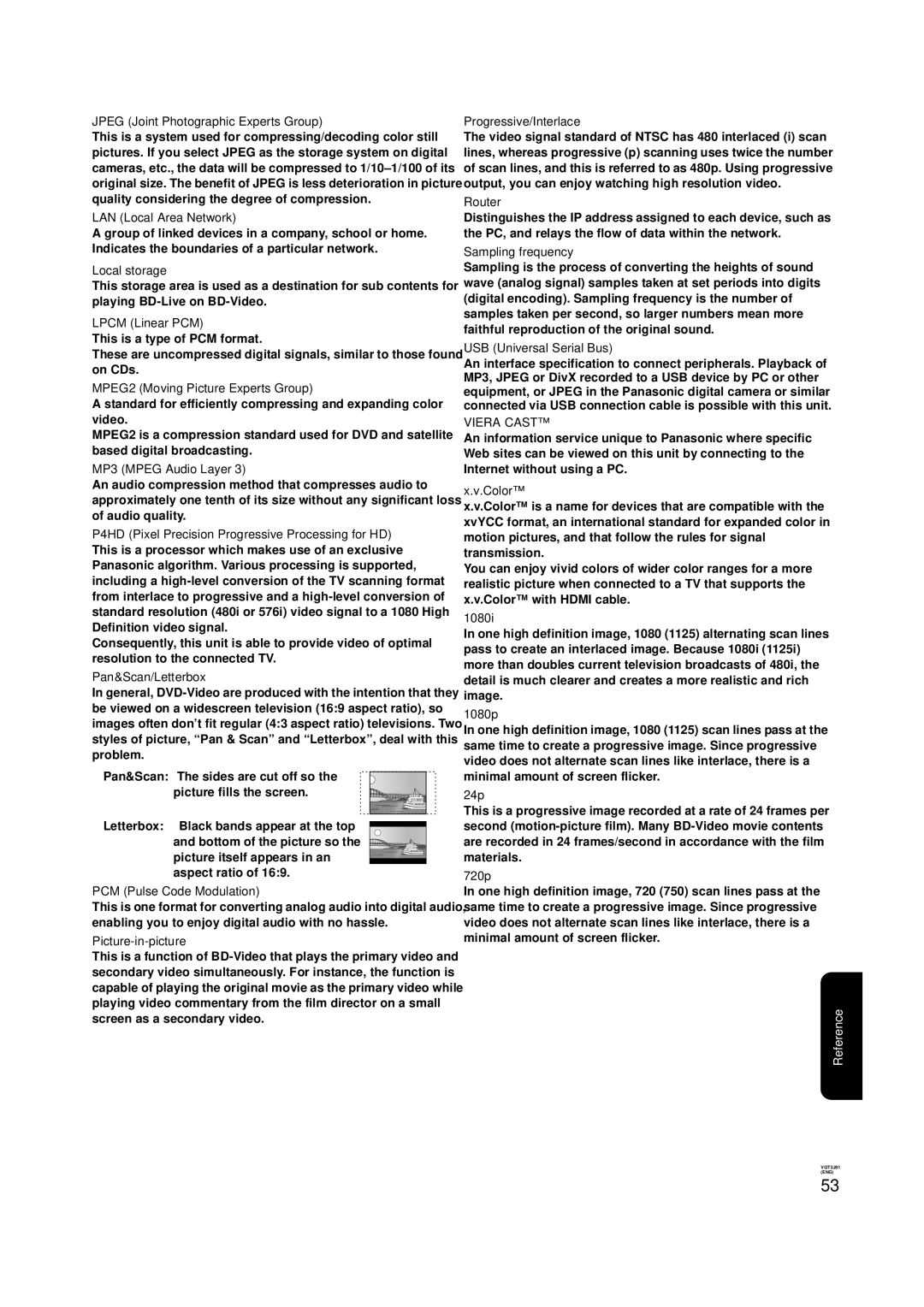
JPEG (Joint Photographic Experts Group)
This is a system used for compressing/decoding color still pictures. If you select JPEG as the storage system on digital cameras, etc., the data will be compressed to
LAN (Local Area Network)
A group of linked devices in a company, school or home. Indicates the boundaries of a particular network.
Local storage
This storage area is used as a destination for sub contents for playing
LPCM (Linear PCM)
This is a type of PCM format.
These are uncompressed digital signals, similar to those found on CDs.
MPEG2 (Moving Picture Experts Group)
A standard for efficiently compressing and expanding color video.
MPEG2 is a compression standard used for DVD and satellite based digital broadcasting.
MP3 (MPEG Audio Layer 3)
An audio compression method that compresses audio to approximately one tenth of its size without any significant loss of audio quality.
P4HD (Pixel Precision Progressive Processing for HD) This is a processor which makes use of an exclusive Panasonic algorithm. Various processing is supported, including a
Consequently, this unit is able to provide video of optimal resolution to the connected TV.
Pan&Scan/Letterbox
In general,
Pan&Scan: The sides are cut off so the picture fills the screen.
Letterbox: Black bands appear at the top and bottom of the picture so the picture itself appears in an aspect ratio of 16:9.
PCM (Pulse Code Modulation)
This is one format for converting analog audio into digital audio, enabling you to enjoy digital audio with no hassle.
Picture-in-picture
This is a function of
Progressive/Interlace
The video signal standard of NTSC has 480 interlaced (i) scan lines, whereas progressive (p) scanning uses twice the number of scan lines, and this is referred to as 480p. Using progressive output, you can enjoy watching high resolution video.
Router
Distinguishes the IP address assigned to each device, such as the PC, and relays the flow of data within the network.
Sampling frequency
Sampling is the process of converting the heights of sound wave (analog signal) samples taken at set periods into digits (digital encoding). Sampling frequency is the number of samples taken per second, so larger numbers mean more faithful reproduction of the original sound.
USB (Universal Serial Bus)
An interface specification to connect peripherals. Playback of MP3, JPEG or DivX recorded to a USB device by PC or other equipment, or JPEG in the Panasonic digital camera or similar connected via USB connection cable is possible with this unit.
VIERA CAST™
An information service unique to Panasonic where specific Web sites can be viewed on this unit by connecting to the Internet without using a PC.
x.v.Color™
x.v.Color™ is a name for devices that are compatible with the xvYCC format, an international standard for expanded color in motion pictures, and that follow the rules for signal transmission.
You can enjoy vivid colors of wider color ranges for a more realistic picture when connected to a TV that supports the x.v.Color™ with HDMI cable.
1080i
In one high definition image, 1080 (1125) alternating scan lines pass to create an interlaced image. Because 1080i (1125i) more than doubles current television broadcasts of 480i, the detail is much clearer and creates a more realistic and rich image.
1080p
In one high definition image, 1080 (1125) scan lines pass at the same time to create a progressive image. Since progressive video does not alternate scan lines like interlace, there is a minimal amount of screen flicker.
24p
This is a progressive image recorded at a rate of 24 frames per second
720p
In one high definition image, 720 (750) scan lines pass at the same time to create a progressive image. Since progressive video does not alternate scan lines like interlace, there is a minimal amount of screen flicker.
Reference
VQT2J81
(ENG)
53
